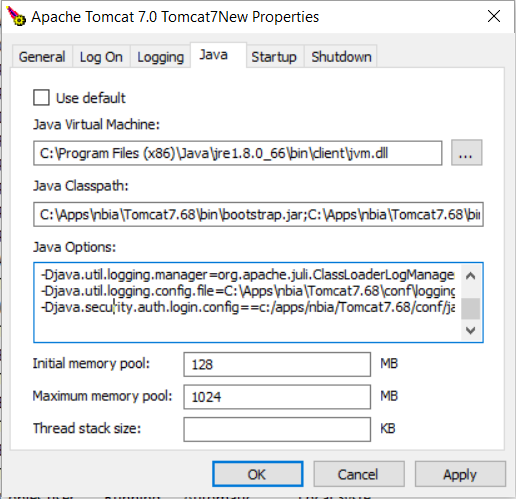Configuring Tomcat 7 Servers and MySQL Server to Run as Services
Continual services
MySQL, the Tomcat server for NBIA, and the Tomcat server optionally installed for UPT must run continually as services. The instructions in this section cover all of these scenarios. For an NBIA 7.0 GA deployment, there are at least three servers, and if UPT is installed, four servers:
- Tomcat 7 (for the NBIA application)
- MySQL 5.5 - Only use this version, as newer versions have not been tested with NBIA.
- CTP (Clinical Trial Processor)
Running Tomcat as a Service
Tomcat with default NBIA
The default NBIA installation runs Tomcat as a command line process using the user currently logged on. Therefore, when you log out as this user, Tomcat is no longer available for NBIA. For that reason, it is recommended that you configure your Tomcat servers to run as a Linux or Windows service. The instructions are contained in this section.
To run Tomcat as a service
Linux
See https://tomcat.apache.org/tomcat-7.0-doc/setup.html. .Windows
To run an existing Tomcat command line installation see https://tomcat.apache.org/tomcat-7.0-doc/windows-service-howto.htmlOnce Tomcat is installed, you will need to provide the Windows Service with the location of jaas.conf in the Tomcat conf directory. Do this by running Configure Tomcat, which was installed with the Windows Service under the Java tab.
Example:-Djava.security.auth.login.config==c:/apps/nbia/Tomcat7.68/conf/jaas.configindicates where the files are.
Important!
You need administrator access to complete this task.
Running MySQL as a Service
Server installed?
It is assumed that your MySQL server was installed as a service. If it was not, follow these recommendations for installing this server as a service.
To run MySQL as a service
Linux
Refer to https://dev.mysql.com/doc/refman/5.5/en/automatic-start.html .- Windows
When installing MySQL server on Windows, choose the option to run MySQL as a Windows service or refer to https://dev.mysql.com/doc/refman/5.5/en/windows-start-service.html for starting MySQL as a Windows Service.


